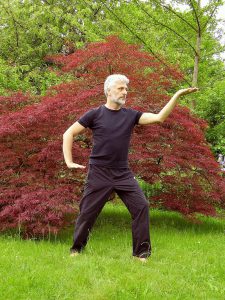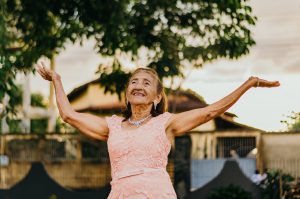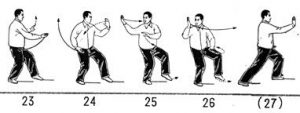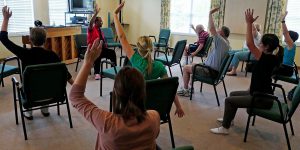A major reason why seniors fall, break a hip, or get injured is due to lack of physical activity, and balance/flexibility issues. As you age, your bones become less dense and more fragile. You may feel less active than you used to be, but that does not mean you cannot pick up a simple, gentle form of exercise. Tai Chi is a form of Chinese martial arts that focuses on slow, controlled movements. It offers so many benefits, mainly being low impact, and improving your balance, and range of motion. It only takes about 20-30 minutes a day, and research shows it can reduce the incidence of falls by almost 45%. Because Tai Chi is non-strenuous and slow moving, it is easy to perform and will enhance your quality of life. May is National Osteoporosis Awareness and Prevention Month, and Tai Chi is a great way to prevent/help with osteoporosis.

What is Tai Chi?
Tai Chi is a form of exercise that does not involve muscle tightening or connective tissue stretching. It developed between 700 and 1500 years ago as a Chinese fighting art, and is often practiced by Chinese seniors every morning! It focuses on mental and spiritual aspects integrated into slow moves which depict animal actions. There are a series of 19 movements, and when performing them you should be breathing deeply but naturally. These movements are done gracefully with meditation. It promotes serenity and inner peace amongst those who do it, creating a better mind-body connection. You can start this form of exercise at any age, and at almost any level of fitness.
The Benefits
Since Tai Chi is a low impact exercise, it has reduced stress on your joints and muscles. It is the ultimate exercise for those challenged by joint and bone issues. The benefits of Tai Chi are endless, especially for older adults.
- Balance Control– Tai Chi improves your balance and stamina. It concentrates on physical components, which do not get used as often the older you become.
- Reduces Chronic Pain– A study showed that seniors who practiced Tai Chi for 1-2 hours a week for 12 weeks had improvements in symptoms of fibromyalgia, arthritis pain, and tension headaches.
- Lowers Diabetes Levels- Researchers found that Tai Chi lowered blood glucose levels of those who have type 2 diabetes.
- Slows Down Parkinson’s– Physical activity has been shown to slow down the deterioration of motor functions. Tai Chi improves stability in patients with Parkinson’s.
- Stronger Muscles– An hour of intense movements delivers the same benefits of taking a brisk walk. It is effective for building muscles.
- Increased Energy

Tai chi offers so many benefits. It increases your energy, mood, balance, sleep, and so much more.
-
Increased Oxygen- Because Tai Chi requires deep steady breaths, your body receives more oxygen. This aids in healing from an injury faster, and reduced blood pressure.
-
Reduced Stress- The practice of Tai Chi is to clear your mind and relax your body. It is meant to tap into a more spiritual side of yourself.
- Improved Mood- Releases endorphins that make you feel good.
- Better Sleep- The same endorphins that improve your mood, also improve your quality of sleep.
-
Faster Recovery- Studies show that heart attack and stroke survivors who practiced Tai Chi recovered at a faster rate!
-
Improved Immune System- You body’s ability to fight off illness declines as you age. Tai Chi has been scientifically proven to improve the immune system.
Simple Moves to Get You Started
Tai Chi is adaptable for all ages, at any fitness level they may be on. It can also be performed in a chair, bed, or wheelchair if you have limited mobility. Make sure to stretch before exercising! Warm up with head rolls, bending down to touch your toes, shoulder rolls, arm circles, and knee circles. Here are a few meditative, slow, and steady Tai Chi moves to start with:
- Golden Rooster Stands on One Leg– Raise one leg, bending at the knee. Stand on one leg for as long as you can before lowering it. Repeat with the other leg. You can use a wall for balance if needed.
-

Brush knee Brush Knee- Bend your elbow and place one hand at chest level. Your wrist should be bent and palm open facing outwards. Your other hand should be at your side with palm facing the opposite direction. Step out. Raise one hand while the other falls with the elbow bent. One palm should face up, while the other faces down.
-
Shooting The Bow- Stand with feet about shoulder-width apart. Relax hands at your sides. Bend your knees slightly, and make fists with your hands and place them in front of your face with fingers facing you. Inhale and pivot at the waist to face your left, extending your left hand directly in front of you. Your left hand should open with the palm facing outward. Pull back slightly with your right fist as if shooting a bow and arrow. Exhale as you return to your starting pose.
- Touch The Sky- Sit up straight. Place your hands in your lap with palms facing upwards and elbows outward. Inhale and raise your hands to chest level, turn your palms outwards and lift your hands above your head. Exhale and gently lower your arms to your sides. Repeat 10 times.

- The Golden Lion Shakes its Mane– Sit up straight. With your hands resting on your thighs, take a deep breath. When you exhale lean forward until you stretch your lower back. Twist your shoulders to one side, while turning your head with your shoulders. Inhale as you return to the beginning position. Exhale and repeat 10 repetitions per side.
